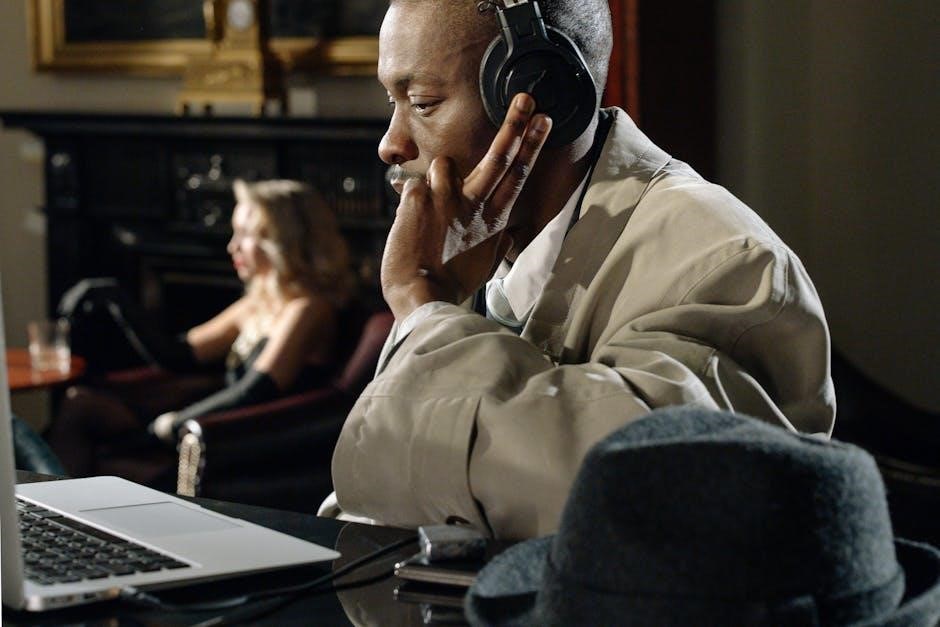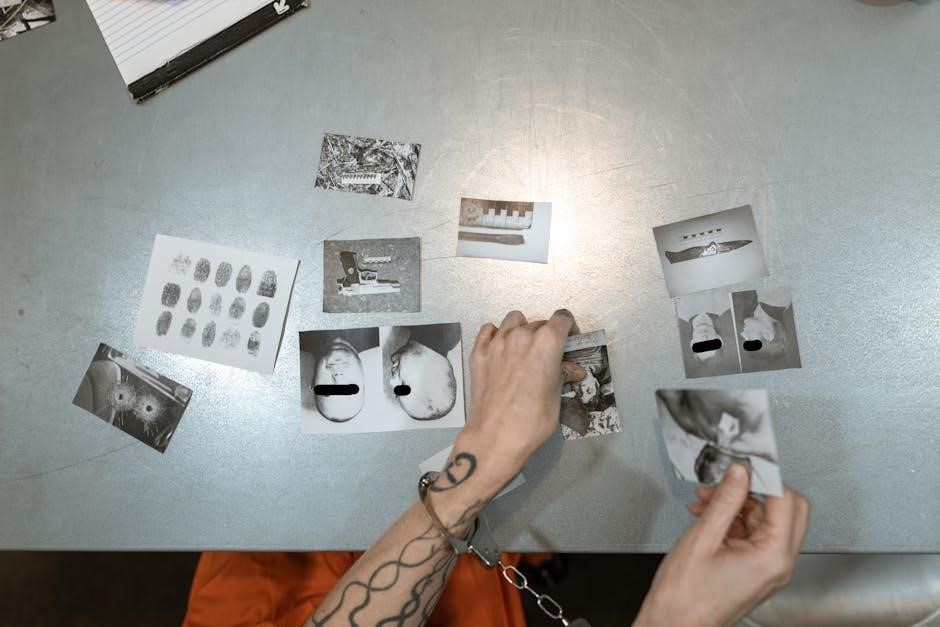Crossword puzzles are engaging and mentally stimulating. Guides and clues help solvers navigate challenges. The “How It’s Made” series provides insights into crafting clues and solving techniques, aiding understanding of crossword mechanics.
1.1 Understanding Crossword Puzzle Basics
Crossword puzzles are structured grids of squares, typically rectangular, where words are filled horizontally (across) or vertically (down). Each square may contain a letter, and the grid is divided into themed sections. Clues are provided outside the grid, offering hints to solve the words. The clues can be straightforward or cryptic, depending on the puzzle’s difficulty. Understanding the grid layout, clue types, and common patterns is essential for solvers. For example, the “How It’s Made” series often involves clues related to everyday objects, requiring solvers to connect descriptive hints to specific terms. Grasping these basics enhances problem-solving skills and makes crosswords more enjoyable.
1.2 Importance of Clues in Crossword Solving
Crossword clues are the backbone of puzzle-solving, guiding solvers through the grid. They provide hints, definitions, or wordplays that lead to the correct answers. Clues vary in difficulty and style, from straightforward definitions to cryptic riddles. In the “How It’s Made” series, clues often describe the manufacturing process of everyday items, testing solvers’ knowledge of production techniques. Clear and well-crafted clues ensure that puzzles are both challenging and solvable, making them more enjoyable. Without clues, crossword puzzles would be indecipherable, as they rely on these hints to unlock the hidden words. Thus, understanding and interpreting clues is essential for mastering crosswords.
1.3 Overview of the “How It’s Made” Series Crossword Clue
The “How It’s Made” series crossword clue is a popular theme in puzzles, often referencing the Science Channel show that explores manufacturing processes. Clues like “How ___ Made” or “How It’s Made network” challenge solvers to identify the show’s title or its broadcaster. These clues frequently appear in crosswords, testing knowledge of both the series and its production focus. Variations include “How It’s Done,” offering similar themes. The clue’s appeal lies in its blend of entertainment and education, making it a favorite for fans of the show and general solvers alike. It effectively combines fun with learning, enhancing the crossword experience.

Breaking Down the “How It’s Made” Crossword Clue
Explore the structure and key elements of the “How It’s Made” crossword clue, analyzing its components and common variations for a deeper understanding of its construction;
2.1 Analyzing the Structure of the Clue
The “How It’s Made” crossword clue often follows a predictable structure, typically starting with a blank space for the answer, followed by the clue itself. For example, “How ___ Made (Science Channel Show)” hints at a 3-letter answer, commonly “IT’S.” The clue’s structure includes the blank space, the clue phrase, and sometimes a hint in parentheses to guide solvers. This format provides both direct and indirect information, helping solvers deduce the answer. The structure may vary slightly, but it consistently includes essential elements like word length and thematic hints, making it easier to identify patterns and solve the puzzle effectively.
2.2 Identifying Key Words and Phrases
Identifying key words and phrases is crucial for solving the “How It’s Made” crossword clue. The clue often contains specific terms like “How ___ Made” or “How Its Made,” which indicate the structure of the answer. Words like “Science Channel Show” or “network” provide contextual hints, narrowing down the possible answers. Phrases such as “How ___ Done” or “How Its Made” series help solvers recognize patterns and themes. By focusing on these key elements, solvers can deduce that the missing word is often a short, common term like “IT’S” or “ITS.” These phrases guide the solver toward the correct answer by emphasizing word length and thematic relevance.
2.3 Exploring Possible Answer Lengths and Patterns
Exploring possible answer lengths and patterns is essential for solving the “How It’s Made” crossword clue. The clue often specifies the number of letters in the answer, such as “(3,3,4),” indicating a three-word phrase with respective letter counts. Patterns like “How ___ Made” suggest a short, common word filling the blank, often “IT’S” or “ITS.” Crossword solvers can use word lists and anagrams to identify potential fits. Additionally, recognizing recurring patterns in clues helps narrow down solutions. For example, the answer “HOW IT’S MADE” is frequently structured as an 11-letter phrase, split into shorter segments to fit the grid. This approach ensures efficient and accurate solving.

Popular Crossword Clues Related to “How It’s Made”
Popular clues include “How ___ Made” (Science Channel show), “How It’s Made network,” and variations like “How It’s Done.” These clues often feature short, common words.
3.1 “How ___ Made” (Science Channel Show)
The crossword clue “How ___ Made” is a popular reference to the Science Channel’s documentary series. The show explores manufacturing processes, making it a common crossword theme. Solvers often fill in the blank with “It’s” or “Its,” as in “How It’s Made.” This clue structure is straightforward, guiding solvers to short, common words. For example, the answer might be a single word like “SCI” (for Science Channel) or “IT’S.” The clue’s simplicity and the show’s popularity make it a frequent feature in crosswords. Recognizing the show’s title is key to solving these clues efficiently.
3.2 “How Its Made” Network
The crossword clue “How Its Made” often refers to the network associated with the popular documentary series. The show, which airs on the Science Channel, has become a common theme in crosswords. Clues frequently hint at the network, with answers like “SCI” (short for Science Channel) or “IT’S” (as in “How It’s Made”). These clues are typically straightforward, guiding solvers to short, recognizable words. The network’s association with educational content makes it a recurring crossword topic. Solvers can identify these clues by recognizing the show’s title and understanding the network’s abbreviation, making them easier to solve.
3.3 “How Its Done” Crossword Clue Variations
The crossword clue “How Its Done” offers various interpretations, making it a versatile entry in puzzles; Variations include clues like “How ___ Done” or “How Its Done,” often referencing processes or methods. Answers may range from short phrases like “HOW” or “IT’S” to longer expressions such as “HOWITS” or “HOWITSDONE.” These clues frequently appear in themed crosswords, especially those focusing on TV shows or educational content. Solvers can identify these clues by recognizing common phrases or patterns. The flexibility of this clue makes it a popular choice for constructors, while its variations keep solvers engaged and challenged.

Strategies for Solving Crossword Clues
Effective strategies for solving crossword clues include analyzing patterns, using word lists, and leveraging solver tools. Recognizing common clue structures and themes can significantly improve solving efficiency. Start with easier clues to build momentum and gradually tackle more complex ones. Cross-referencing answers and utilizing anagram tools can help decode tricky entries. Additionally, understanding clue types, such as puns or anagrams, enhances problem-solving skills. Regular practice and staying updated with crossword trends are essential for mastering these strategies and becoming a proficient solver.
4.1 Using Word Lists and Anagrams
Word lists and anagrams are powerful tools for solving crossword clues. Organized lists of words by length or starting letters can help identify potential answers quickly. Anagrams, which rearrange letters, are especially useful for clues with scrambled patterns. For “How It’s Made” crossword clues, focusing on common prefixes or suffixes can narrow down possibilities. For example, recognizing that “made” often follows “how it’s” can guide solvers to the correct answer. Additionally, using online anagram solvers or word pattern generators can reveal hidden connections. Regular practice with anagrams improves pattern recognition, making it easier to tackle similar clues in the future. These techniques build a mental lexicon that enhances crossword-solving efficiency.
4.2 Leveraging Crossword Solver Tools
Crossword solver tools are invaluable for tackling challenging clues. These tools, available online or as desktop applications, can quickly generate possible answers based on partial letters or patterns. For clues like “How It’s Made,” solvers can input known letters or phrases to find matching answers. Advanced features, such as anagram generators and pattern matching, help decipher tricky clues. Many tools also provide definitions and usage examples, aiding in understanding context. Regular use of these resources can enhance problem-solving skills and reduce frustration. Additionally, crossword solver tools often include databases of past puzzles, offering insights into common clues and patterns, making them indispensable for both beginners and experienced solvers.
4.3 Applying Pattern Recognition Techniques
Pattern recognition is a powerful strategy for solving crossword clues. By identifying common word lengths, letter frequencies, and clue structures, solvers can narrow down potential answers. For example, recognizing that a clue like “How It’s Made” often refers to a specific TV show or network can guide the solver. Online resources and databases reveal frequent patterns in clues, helping to predict answers. Additionally, noting recurring prefixes, suffixes, and anagrams can unlock difficult clues. This method enhances problem-solving efficiency and accuracy, making it easier to tackle even the most challenging puzzles with confidence and precision.

Tips for Constructing Crossword Clues
Crafting effective crossword clues requires clarity, brevity, and creativity. Use straightforward language, avoid ambiguity, and ensure clues align with answer lengths and patterns, enhancing solvability and fun.
5.1 Writing Clear and Concise Clues
Writing clear and concise clues is essential for creating solvable crosswords. Use straightforward language to ensure clues are easily understood. Avoid ambiguity by making sure each clue leads directly to one answer. Ensure clues align with the answer’s length and pattern. Clarity enhances the solver’s experience, making crosswords enjoyable and challenging. Conciseness prevents confusion, keeping the focus on the puzzle’s fun aspect. By balancing simplicity and creativity, constructors can craft clues that guide solvers effectively without frustration.
5.2 Avoiding Ambiguity in Clue Writing
Avoiding ambiguity in clue writing is crucial to ensure solvers can interpret clues correctly. Use precise language and avoid multiple interpretations. Ensure clues are specific to the answer, eliminating alternative meanings. Test clues for clarity to prevent confusion. Ambiguous clues can frustrate solvers and detract from the puzzle’s enjoyment. Clarity and specificity are key to maintaining trust and engagement. By crafting unambiguous clues, constructors create a fair and rewarding experience for solvers of all skill levels. This approach fosters a positive interaction with crosswords, making them accessible and enjoyable for everyone involved.
5.3 Balancing Difficulty Levels for Different Audiences
Balancing difficulty levels in crossword clues ensures the puzzle appeals to a wide range of solvers. Constructors should consider the audience’s skill level when crafting clues. Beginner-friendly clues may use straightforward definitions or synonyms, while experienced solvers can tackle more complex or abstract clues. Varying clue difficulty within a puzzle keeps it engaging and prevents frustration. Testing clues with diverse groups helps identify the right balance. This approach ensures that crosswords remain accessible and enjoyable for both novices and experts, fostering a positive experience for all participants. Properly balanced difficulty levels are key to creating a crossword that resonates with its intended audience.

Resources for Crossword Enthusiasts
Explore online crossword databases, puzzle apps, and enthusiast communities for access to clues, solving tools, and expert tips. These resources enhance both learning and enjoyment of crosswords.
6.1 Online Crossword Databases and Archives

Online crossword databases and archives are invaluable resources for enthusiasts. Platforms like Crossword Tracker and Crossword Solver offer extensive libraries of clues and answers, aiding solvers in finding solutions quickly. These databases often organize clues by difficulty, length, and category, making them user-friendly for both beginners and experts. Additionally, archives of past puzzles from major publications, such as The New York Times and LA Times, provide access to a wealth of practice material. Many databases also feature advanced search options, allowing users to filter by specific themes or keywords, such as “How It’s Made,” to refine their results efficiently.
6.2 Crossword Puzzle Apps and Software
Crossword puzzle apps and software are essential tools for modern solvers; Apps like Crossword Puzzle Free and Crosswords With Friends offer daily puzzles and interactive features. Many apps provide built-in hint systems, timers, and achievements to enhance the solving experience. Software tools, such as Armored Penguin Crosswords, cater to constructors, allowing them to create and edit puzzles with ease. These platforms often include libraries of puzzles, making them ideal for practice. Additionally, some apps offer learning resources and tutorials, helping beginners improve their skills. With features like accessibility modes and offline access, crossword apps and software are versatile solutions for enthusiasts of all levels.
6.3 Communities and Forums for Crossword Fans
Crossword enthusiasts often connect through online communities and forums to share insights and strategies. Platforms like Reddit’s r/CrosswordPuzzles and r/NYTcrossword foster discussions among solvers. Specialized forums, such as Crossword Forum and Puzzle Society, offer spaces for exchanging hints and solutions. These communities provide valuable resources, including tips from experienced constructors and solvers. They also host competitions and collaborative solving events, fostering camaraderie. Many forums feature archives of past puzzles and clues, making them indispensable for learning and improvement. Engaging with these communities enhances problem-solving skills and keeps enthusiasts updated on the latest crossword trends and techniques. They are a cornerstone of the crossword-solving culture, promoting both learning and enjoyment.

Advanced Techniques for Expert Solvers
Expert solvers use cross-references, anagrams, and pattern recognition to tackle complex clues. They master cryptic clues, themed puzzles, and competitive strategies, enhancing their problem-solving efficiency and accuracy.
7.1 Using Cross-References and Interlocking Answers
Advanced solvers leverage cross-references and interlocking answers to tackle complex puzzles. By identifying overlapping letters between Across and Down clues, they can deduce answers more efficiently. This technique enhances pattern recognition and reduces guesswork. Cross-references also help in verifying the accuracy of answers, ensuring consistency across the grid. Expert solvers often use word lists and anagrams to identify potential matches for partial answers. Interlocking answers provide a framework for building solutions incrementally, making even the most challenging clues manageable. This method is particularly effective in themed crosswords, where interconnected answers reveal the puzzle’s overarching theme or pattern.
7.2 Mastering Cryptic and Themed Crosswords
Cryptic and themed crosswords present unique challenges that require advanced techniques. Cryptic clues often involve wordplay like anagrams, charades, or double definitions, demanding sharp linguistic skills. Themed crosswords, meanwhile, feature interconnected answers tied to a central concept; To master these, solvers must first identify the theme or underlying pattern, as it often provides crucial context for solving individual clues. Practice with cryptic clues helps develop the ability to recognize wordplay quickly. Themed crosswords benefit from a systematic approach, starting with the most obvious clues to unlock the theme. Both types require patience, creativity, and a deep vocabulary, making them rewarding for experienced solvers.
7.3 Solving Crosswords for Competitive Events
Competitive crossword solving demands speed, accuracy, and strategic thinking. Participants often face strict time limits, requiring quick recognition of patterns and clues. Training with timed exercises and advanced solver tools can enhance performance. Understanding common themes and high-frequency answers is crucial, as competitive crosswords frequently incorporate recurring patterns. Experienced solvers also benefit from memorizing word lists and mastering anagram techniques. Mental stamina and focus are key, as pressure increases during events. Using elimination methods and cross-referencing clues can help navigate challenging grids efficiently. Competitive crossword solving is as much about strategy as it is about knowledge, making it a thrilling challenge for skilled enthusiasts.

Common Mistakes to Avoid in Crossword Solving
Overlooking obvious clues, misinterpreting clue meanings, and ignoring crossword etiquette are common mistakes. These errors can hinder progress and lead to incorrect answers or incomplete puzzles.
8.1 Overlooking Obvious Clues
Overlooking obvious clues is a common mistake that can stall progress. Many solvers rush through puzzles, missing straightforward answers hidden in plain sight. For instance, clues like “How ___ Made” often relate to the Science Channel show, but solvers might overcomplicate the answer. To avoid this, start with easier clues and use tools like word lists or anagram solvers to spot simple solutions. Pay attention to short answers, as they are often the most direct. Crossword solvers and databases can also highlight overlooked clues, ensuring no obvious answers slip by. This strategy helps build momentum and reduces frustration during the solving process.
8.2 Misinterpreting Clue Meanings
Misinterpreting clue meanings is another common pitfall. Crossword clues often rely on wordplay, puns, or double meanings, which can lead to confusion. For example, the clue “How ___ Made” might be mistaken for a general question about manufacturing rather than referencing the Science Channel show. Solvers must carefully analyze phrasing and consider both literal and metaphorical interpretations. Overcomplicating clues or assuming a single meaning can lead to incorrect answers. Using crossword solver tools or databases can help clarify ambiguous clues. Additionally, cross-referencing answers with other clues in the puzzle can provide context and reduce misinterpretation, ensuring a smoother solving experience. Attention to detail is key to avoiding this mistake.
8.3 Ignoring Crossword Puzzle Etiquette
Ignoring crossword puzzle etiquette can hinder the solving experience. Proper etiquette includes respecting other solvers, avoiding cheats, and following community guidelines. For example, using crossword solver tools excessively can detract from the challenge. Additionally, sharing answers without consent can spoil the puzzle for others. Etiquette also involves acknowledging the work of constructors and adhering to rules in competitive events. Ignoring these norms can lead to frustration and a negative environment for all participants. By embracing good etiquette, solvers can enjoy a more rewarding and collaborative crossword experience, fostering a sense of camaraderie and shared enjoyment among enthusiasts.
Mastering crossword clues requires patience, practice, and strategy. Leverage resources, stay updated, and engage with communities to enhance your skills. Keep solving and enjoy the journey!
9.1 Summarizing Key Takeaways
Solving crosswords effectively involves understanding clue structures and patterns. The “How It’s Made” series offers insights into crafting and solving clues, emphasizing strategy and practice. Key takeaways include leveraging word lists, anagrams, and solver tools to enhance skills. Recognizing patterns and avoiding common mistakes like misinterpreting clues or ignoring etiquette is crucial. Staying updated with trends and engaging with crossword communities can further improve expertise. Continuous learning and practice are essential for mastering crosswords, ensuring a rewarding and enjoyable puzzle-solving experience. By applying these strategies, solvers can confidently tackle even the most challenging clues and expand their crossword knowledge.
9.2 Encouraging Continuous Learning and Practice
Continuous learning and practice are vital for improving crossword-solving skills. Exploring resources like online databases, apps, and communities provides access to diverse clues and strategies. Regularly solving puzzles helps build familiarity with clue patterns and wordplay. Engaging with themed crosswords, such as the “How It’s Made” series, enhances understanding of specific topics. Leveraging tools like word lists and solvers can also aid in mastering techniques. Practicing consistently sharpens problem-solving abilities and expands vocabulary. By staying curious and dedicated, solvers can gradually tackle more complex puzzles, enjoying the intellectual challenge and satisfaction of crossword completion.
9.3 Staying Updated with Crossword Trends
Staying updated with crossword trends ensures solvers remain competitive and engaged. Following crossword constructors, blogs, and forums provides insights into emerging patterns and themes. Subscribing to puzzle apps and online databases keeps solvers informed about new clues and formats. Participating in crossword communities and events exposes enthusiasts to fresh challenges and strategies. Tracking trends like themed crosswords or interactive puzzles enhances problem-solving skills. Regularly exploring resources and staying connected to the crossword community fosters continuous improvement and keeps the hobby exciting. By staying informed, solvers can adapt to evolving trends and enjoy the dynamic nature of crossword puzzles.

Frequently Asked Questions (FAQs)
What is the best way to start solving crosswords? Begin with simple puzzles and use guides for clues.
How can I improve my crossword solving skills? Practice regularly and explore solver tools.
What are the most reliable crossword solver tools? Utilize online databases and trusted apps.
10;1 What is the Best Way to Start Solving Crosswords?
Starting with simple crosswords is a great way to build confidence. Begin by tackling puzzles with straightforward clues and gradually move to more complex ones. Use online guides and solver tools to understand patterns and techniques. Pay attention to common crossword conventions, such as word lengths and themes. Practice consistently to improve pattern recognition and vocabulary. Utilize crossword apps or websites that offer tutorials and tips for beginners. Over time, you’ll develop the skills to approach even the toughest puzzles with ease. Remember, patience and persistence are key to mastering crosswords.
10.2 How Can I Improve My Crossword Solving Skills?
Improving crossword skills requires consistent practice and strategic approaches. Start by solving puzzles daily, beginning with easier ones and gradually tackling harder crosswords. Expand your vocabulary by reading books, articles, and learning new words. Use crossword solver tools and guides to understand clues and patterns. Join crossword communities or forums to share tips and learn from experienced solvers. Pay attention to common crossword conventions, such as anagrams and wordplay. Study past puzzles to recognize recurring themes and answer patterns. Over time, these techniques will enhance your ability to solve crosswords efficiently and confidently.
10.3 What Are the Most Reliable Crossword Solver Tools?
Reliable crossword solver tools are essential for assisting solvers at all skill levels. Crossword Solver and Crossword Clue Solver are popular choices, offering anagram solutions and pattern recognition. Crossword Puzzle Answers provides extensive databases for quick lookups. Additionally, apps like Crossword Buddy and Crossword Assistant offer real-time help. These tools often include features like cross-reference checks and themed puzzle support. Many also integrate with online communities, allowing users to share solutions and tips. For competitive solvers, advanced tools with AI capabilities are increasingly popular. These resources not only aid in solving but also enhance learning and improvement in crossword puzzle techniques.